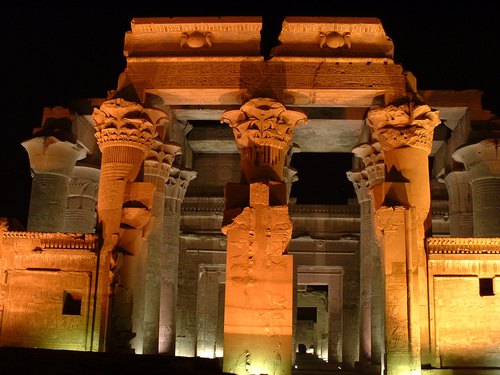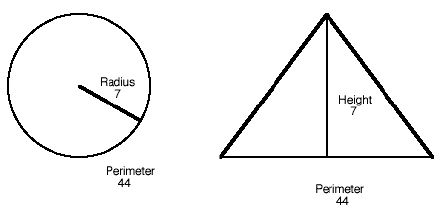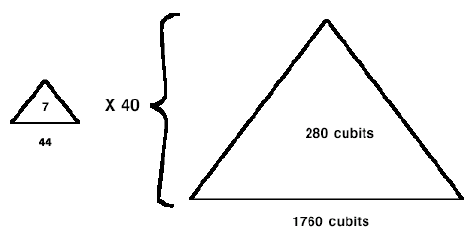
Imperial Measures
As was explained in some detail by P J Crowe in the last issue of SIS Review, the number 40 is a favourite of the biblical scribes, but why? The answer to this is remarkably simple, but there is a great deal of background information that needs to be understood before this simplistic answer can be recognised. The most important thing to note is that measurements and numerology were very important in ancient times and also within the biblical texts. It was interesting to note the cleric's view in Crowe's article, which was that 'no numbers in the Bible should be considered or used mathematically'. This is simply theological obfuscation, the Bible painstakingly details the measurements of many structures, and many of these measurements were originally considered sacred. Indeed, Jesus was not simply a carpenter, but a tekton (tektwn) or an architect.
Sir Isaac Newton was searching for these biblical sacred measurements when he wrote his booklet entitled "Dissertation upon the Sacred Cubit of the Jews and other nations". Newton was interested in the precise length of the cubit that was being used in these biblical dimensions, but he discarded the unit that I believe was being used - the Royal or Thoth cubit of Egypt measuring 52.35cm. The prophet Ezekiel appears to confirm my assumption when he says that the cubit length used for the altar of the Temple of Jerusalem was 'a cubit and a hand breadth'. This cubit-plus-a-hand was the exact dimension of the Royal/Thoth cubit.
I have detailed this argument more fully in the book Thoth, Architect of the Universe, but we can see here the foundations of the original import of numerology and measurement systems within the Bible. The answer to why the number 40 was so important is contained within these measurement systems and so a detailed look at some of these is necessary. Remarkably, the first location to look at in this regard, is Britain and its arcane usage of the Imperial Measurement System.
Imperial
Imperial Measurements, two words guaranteed to produce a shudder of horror in all school children until the coming of metrication. Nobody understood the system and it beggared belief that anyone would want to create such an unwieldy system in the first place - so where did it come from and why did it manage to last so long?
This is actually a serious question - exactly why was this complex system of measures invented? Does anyone really know? From the British perspective, the system seemed quite natural; having 14 pounds to the stone and 12 pence to the shilling were just part of the initiation into the culture, no more peculiar than having milk delivered to the doorstep. To the rest of the world, however, it would seem that the figures of 1,760 yards to the mile and 51/2 yards to the rod were plucked out of thin air. For who, in their right mind, would create a system of units that used fractions? Indeed, this mismatch of odd numbered units in the Imperial System has caused many eminent heads to be scratched over the years. No less an authority than Professor R. Connor, who has been working on weight and measures for more than forty years (sic), says of the Imperial system of measures:
If we look again at the table of length, we might agree that the relation of inches to feet and feet to yard are not unreasonable, nor is that of the relation of rods to furlong to mile, but the entry '51/2 yards = 1 rod' strikes a discordant note. For who in his right mind would establish a table of relationships using fractional parts? ... it can be taken for granted that the table was not set up 'de novo' (as new), but that two or more systems were being fused together to meet the needs of the times.
This is all very logical: the foot and yard were part of one measurement system and the furlong and rod were part of another. Where they met formed that uncomfortable 51/2 yards to the rod. But this does not exactly explain all the other odd ratios in the system, for instance, the 8 furlongs to the mile, the 320 rods to the mile and the 1,760 yards to the mile. They seem to be bizarre numbers; there has to be a simpler and more comprehensive solution to this problem than the fusion of two measurement systems.
That there may be some all-encompassing rationale to the system is borne out by some of its underlying symmetry, for even that rather odd sounding 51/2 yards to the rod still manages to work well throughout the system. The following are divisions of the Imperial System, expressed in yards and rods, yet both sides of the table are expressed in round numbers. One has to admit that the system does have an unexpected symmetry to it:
1760 yards (1 mile) divided by 5.5 = 320 rods,
220 yards (1 furlong) divided by 5.5 = 40 rods,
22 yards (1 chain) divided by 5.5 = 4 rods,
1 acre = 22 x 220 yds which is 4 x 40 rods.
The ease with which the 51/2 yard rod fits into the system has been recognised in the expert field as well. Professor Connor continues:
The pivot of the table of length, is the rod. It generates not only the furlong as a unit of length, but also the acre...
But this is a contradiction of the previous statement: the rod unit cannot be both the pivotal unit and also the accidental result of the fusion of two different systems. It would seem that the experts have come to no real conclusions beyond the 'fact' that the yard is a nice convenient household length and that a mishmash of units has grown up around it. For a long time I found this deeply unsatisfactory and I determined to find a better solution.
At last, after much patient study of the ancient texts, there does seem to be an alternative and very attractive solution to this age-old conundrum. Additionally, it is an answer that is relatively simple, which, according to the premise known as Occam's razor, is always the test of a good theory.
Pi units
The solution I am proposing is that the whole table of units was based on the mathematical constant Pi. It is this use of Pi as a base structure to the Imperial Measurement System that has determined its peculiar nature and has also determined the length of that awkward 51/2-yard rod. Pi is not a nice round decimal number and therefore does not lend itself easily to sub-divisions. It is also a fixed constant of nature, so there is not much that can done about that - the value of Pi cannot be changed, it just has to be circumvented. So if a designer wished to encompass the value of Pi into a building or, indeed into a measurement system, the obvious solution would be to choose an approximation of Pi that was divisible by even units. A fraction of 22 : 7 springs to mind as an obvious choice, it is a very simple approximation of the precise Pi number and it also has an even numbered numerator - the number 22.
My proposal is that the Pi ratio used in all of the Imperial System was 22 : 7. The numerator in this ratio, the number 22, is fundamental to the way in which the system was designed, it is the the base unit. Thus when looking at the Imperial system, it can be seen that there are 22 yards in a chain. Multiply this by ten and we find that the furlong is 220 yards. Finally, when going down the scale, if the number 22 is divided by 4 it produces the rather odd looking rod length of 51/2 units.
It would appear that there is a very simple solution to the peculiarities of the Imperial Measurement System; and that awkward 51/2 yard rod is simply a necessary by-product of our starting point of Pi. For Pi-based measurements to work out in even units, we have to use a multiple of 5.5 somewhere in the measurement system. The British Imperial Measurement System was not, therefore, just plucked out of thin air, it was a system based on Pi.
But if this is so, the implications are manifold and quite interesting, for it is indicating that the knowledge of the fractional approximation of Pi was known long ago. If this is so, the important question then comes - how long ago was this fraction of Pi known? How old is the Imperial measurement System? Some further investigation may provide an answer.
Pi Mile
Having found the symmetry of the sub-units of this measurement system, it is time to look at the mile length. When making this wonderfully new set of measurements, based on Pi, why would someone want to make them have such an awkward end-point; why derive the peculiar mile length of 1,760 yards? Where did this peculiar length come from? Well, as one might expect, this is another result of using Pi-based units; the result of using the 5.5 unit rod that is so central to this system.
The number 1760 is another Pi based number, a multiple of the Pi numerator of 22 units (22 : 7). Multiply 22 by 80 and we find that the mile is 1760 yards. Therefore any of the other sub-units in the system (which are based on the number 22, as in the table above) will happily divide into the mile length, including that awkward 5.5 yard rod. The result being that there are 320 rods, or 80 chains, or 8 furlongs to the mile.
This just has to be the most logical reason yet given for the mile length in the British Imperial Measures. Someone back in the dim and distant past knew of the fractional value of Pi and decided to encapsulate this into a new measurement system, one that has endured over the millennia into the present era. But the question still remains as to how and why was that done? How old is our Imperial Measurement system?
What follows may seem a little esoteric to some within the scientific community, but the artifacts are out there for anyone to witness and measure. One may disagree with the final interpretations that are made in the book 'Thoth, Architect of the Universe', but nevertheless facts are facts and there is an underlying simplicity to what follows. Why the caution at this point in this thesis? Well, put simply, the Imperial Measurement System was quite possibly derived from the construction of the Great Pyramid of Giza in Egypt!.
Now that may seem like a bold statement to make, but there are some good reasons for doing so. Firstly, it is true that the dimensions of the Great Pyramid, like the Imperial Measurements, are based on the function of Pi. As I shall show shortly, in numerical terms, the height of this pyramid is a representation of the radius of a circle and the circumference is a representation of the circle's circumference. Thus, if the pyramid were 7 units high, the perimeter would be 44 of those same units (7 : 44). And if we include the number of '2' from the circumference formula, I think the Pi fraction of 7 : 22 can be clearly seen in the pyramid dimensions below.

Fig. 1 Great Pyramid of Giza as representation of a circle
So the Great Pyramid and the Imperial Measures appear to have been based on the same mathematical function - Pi, but where does the mile fit into all this? Well it is obvious that the pyramid does not really measure 44 units around the base, and to simply state that it measures 921.36 meters or even 3022 Imperial feet around the base means absolutely nothing. It is axiomatic that the Egyptians were using cubits, not feet or meters, and so it is to cubits we should look when deriving the measurements of the pyramids. The precise unit the Egyptians used was derived by Sir Isaac Newton in the 17th century, in his small booklet entitled "Dissertation upon the Sacred Cubit of the Jews and other nations". He ascertained the length by deriving that the King's chamber in the pyramid was constructed to be 10 x 20 cubit lengths, and the resulting unit has a length of 52.35 centimeters (20.6 inches).
If we were to use this original unit to measure the circumference, we would discover, to our amazement, that the great Pyramid has a perimeter length of 1760 royal cubits - the same number of units as the 1760 yard Imperial mile. The absolute length of the cubit and the yard are different, of course, but the numerical symmetry remains the same.
The accepted modern measurements for the Great Pyramid bear out this claim in a rather precise manner. Mark Lehner, author of the standard reference work entitled The Complete Pyramids, gives the dimensions of the Great Pyramid of 230.33 x 146.59 meters (perimeter length and height). Using the Royal or Thoth cubit length of 52.35cm, these measurements show that the ancient architect who designed this pyramid was using dimensions of 1759.9 x 280.02 cubits. Indeed, just to confirm this claim, Lehner then gives the Great Pyramid a slope angle of 51ş 50' 40", whereas the actual angle of a Pi (22:7) shaped pyramid would be 51ş 50' 34". This angle is within 6 seconds of arc away from the true figure and it means that the pyramid's height is accurate to within 1.5 centimeters over a total of 146.6 meters! Given the accuracy of this symmetry between the pyramid and Pi, it is rather surprising that Lehner does not mention Pi at all.
Many may claim that this symmetry with Pi is mere coincidence, many may also say that the Imperial Measurement System is simply a base 22 numeric system and nothing to do with Pi.
I would disagree. Firstly, it has been long rumoured in mythology, that the measurements of the Great Pyramid were somehow special. That is why Sir Isaac Newton wrote his pamphlet in the first place, in which he ponders over the dimensions of the Great Pyramid at Giza and many other ancient monuments. It is perhaps a shame that the base of the pyramid was covered in rubble in those times and that the perimeter length he was using was considerably short of the true length, otherwise Newton would certainly have discovered the same coincidence. Secondly it is a fact that the Great Pyramid not only contains the perimeter length of 1760 cubits, but also a height of 280 cubits. Thus this stupendous edifice, designed and erected some say in the early Bronze Age, is, as stated above, simply a representation of the circle formula of; circumference = 2 Pi x r. So the ratio chosen for the design of the Great Pyramid was simply a 40 times multiple of the fractional approximation of Pi,
22 x 40 = 880, 7 x 40 = 280, pyramid ratio = 880:280
The base of the Great Pyramid Pyramid is then multiplied by 2 (2 Pi x r), 2 x 880 = 1,760.

Fig. 2 Great Pyramid a 40 times copy of Pi.
Therefore, the Imperial Measurement System is not only based on Pi, but the units and multiples of units also conform to those used both externally and internally at the Great Pyramid. Thus the pyramid appears to be a mathematical and meteorological constant carved not only into the fabric of these ancient monuments, but also (latterly) into the culture of the Anglo-Saxon peoples.
But there is a further conundrum that needs further explanation - the role of the number 40 within biblical literature, just why was it considered so important? The answer lies in the role of Giza in the biblical texts. The whole story is too complicated to explain in this short article, but the whole thrust of my books Jesus, Last of the Pharaohs and Tempest & Exodus is that the heroes of the Old Testament Bible (the Torah) were actually very important people. In fact the Israelites were the Hyksos people of Egypt, and the Israelite exodus was the Hyksos exodus from Egypt.
It so happens that these to exodus events are identical in every respect apart from their dating.
The dating issue can be resolved to great satisfaction, but the obstacle that prevent this association from being widely accepted is that if the Hyksos were the Israelites, then the Hyksos leaders were the Israelite leaders. In turn, this directly implies that, since the Hyksos leaders were pharaohs of Egypt, then the Israelite leaders must have been pharaohs of Egypt. Theologians and Egyptologist alike find this concept rather too hot to handle. Such a scenario may also seem unsubstantiated and untenable, but it is a fact that the first Hyksos pharaoh was called Mam-Aybre, while the first Israelite patriarch was called Abra-Ham.
In the book Tempest & Exodus, I then go on to explore the religion of the Hyksos in comparison to that of the Bible and some remarkable coincidences started to highlight themselves. The prime result of this investigation was the distinct possibility that the Great Pyramid of Giza is mentioned many times within the biblical texts, it is just that its name has been changed to Mt Sinai.
You can take or reject this scenario as you wish, but the bottom line is that from Abraham to Joseph (who was the second most powerful man in Egypt after the pharaoh), the links between biblical history and Egypt are very strong indeed. It was from those links that the importance of the number 40 slipped into biblical history.
The number 40 was a secret that explained the function of the Great Pyramid as being a mathematical equation - a physical embodiment of the circle formula. To understand this, however, one had to know the Pi formula of 22:7 and how that formula was used within the structure of the pyramid. Knowing that the perimeter length was 1760 cubits was not enough, look at how many people have seen the pyramid measurements and the Imperial mile length without knowing that Pi was involved in these numbers. What the initiate required was the conversion factor of 40, which changed the dimensions of 1760:280 into the Pi circle formula of 44:7. As an aside, the reason for using the Pi approximation of 22:7 (44:7), is that only in this way can both the height and the base-length of the pyramid be derived in whole numbers. Had an accurate Pi been used, one of these dimensions would have had to have been fractional.
Israelite religion was based on initiation and I would propose that this number 40 was just one of those secret and sacred initiations. Asking people if they thought that the Great Pyramid was '40 years old', for instance, would instantly differentiate between the initiated and the profane. It was this covert advertisement of who was initiated and who was not that lay behind the numerous references to the number 40 within the Bible. In order to denote which kings and priests had been fully initiated into the numerology of the Great Pyramid, these important figures were subsequently said to had reign lengths or life-spans of 40 years. Those in the know understood immediately, while the rest have wondered and speculated for millennia...
Fascinating, is it not?
R. Ellis has asserted his rights, in accordance with the Copyright, Designs and Patents Act 1988 to be identified as the author of this work.














































Pokud chcete ocenit naši práci, můžete ZDE